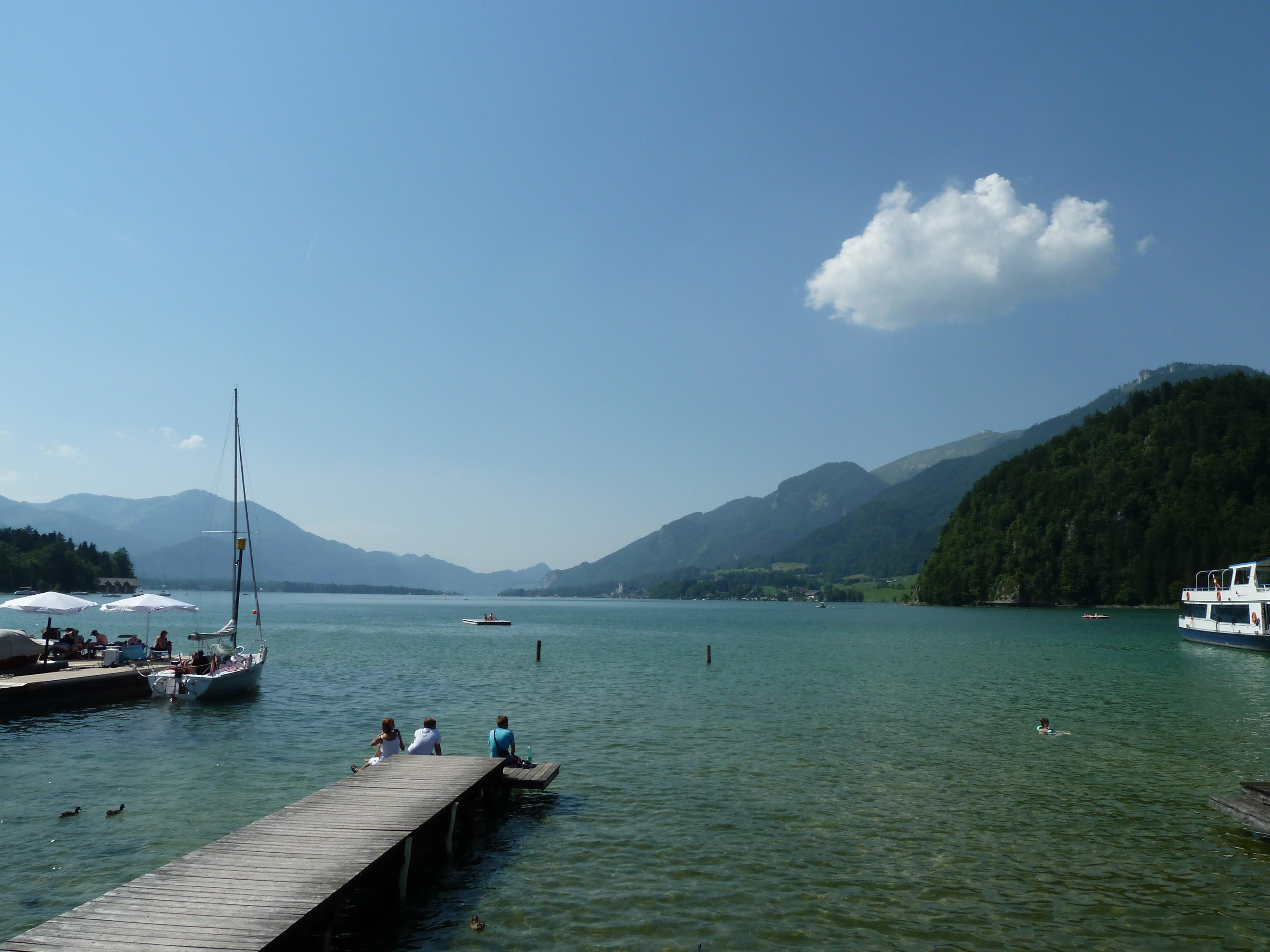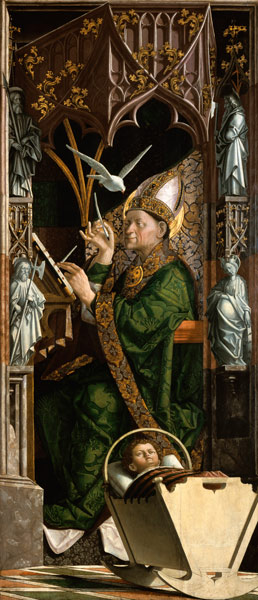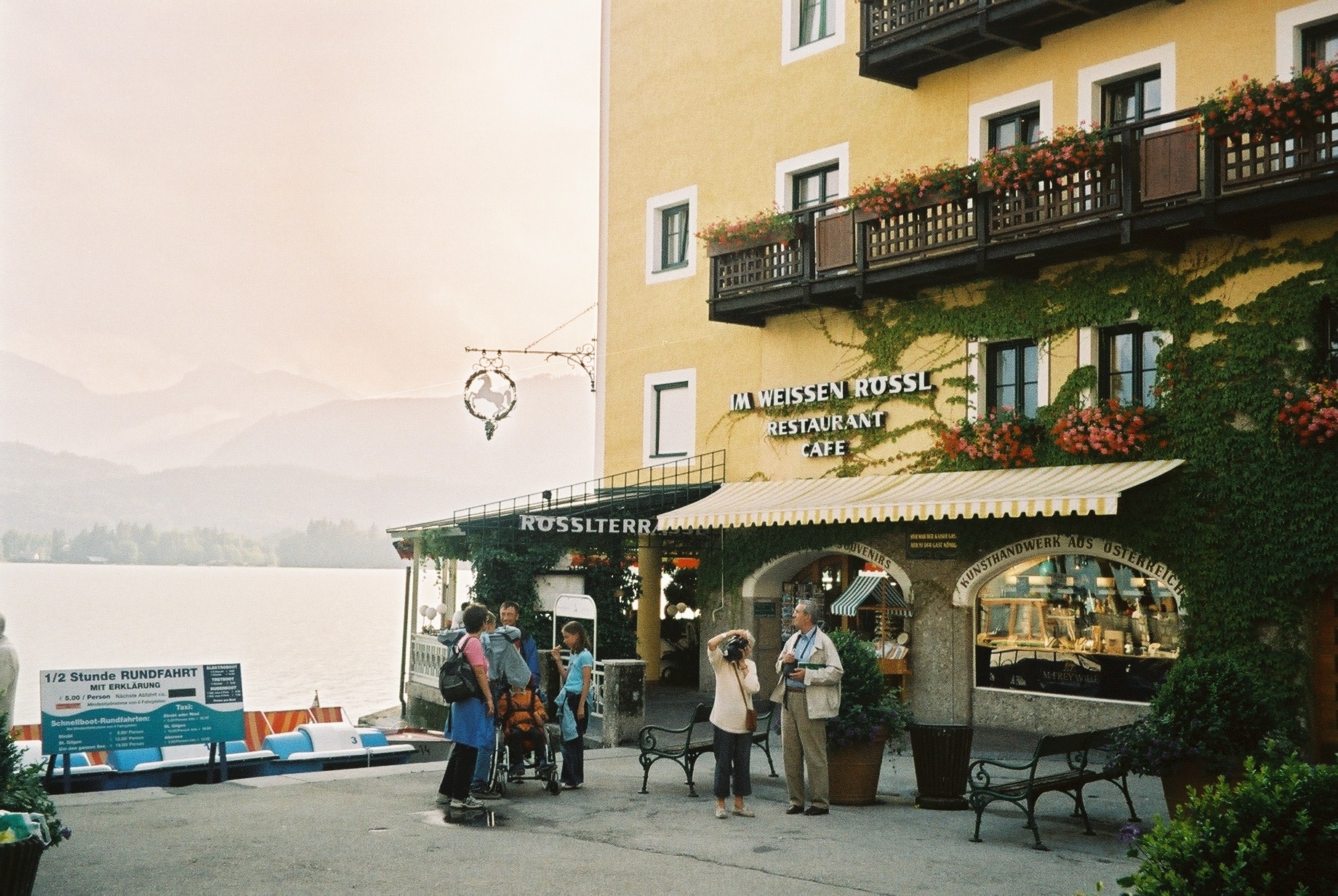|
Sankt Wolfgang Im Salzkammergut
St. Wolfgang im Salzkammergut is a market town in central Austria, in the Salzkammergut region of Upper Austria, named after Saint Wolfgang of Regensburg. Geography The town is located in central Austria. It is on the northern shore of the Wolfgangsee lake (close to the towns of Strobl and St. Gilgen, both in the State of Salzburg) at the foot of the Schafberg mountain. Populated places The municipality of St. Wolfgang in Salzkammergut consists of the following cadastral communities: St. Wolfgang (2.337,24 ha) and Wolfgangthal (3.319,61 ha); while further subdivided into twelve populated places (with population in brackets as of 1 January 2024). * Aschau (34) * Au (378) * Bürglstein (3) * Graben (183) * Markt (598) * Mönichsreith (95) * Radau (338) * Rußbach (321) * Schwarzenbach (213) * Weinbach (339) * Windhag (214) * Wirling (181) Culture St. Wolfgang's tourist attractions include the ''Schafbergbahn'' (a rack railway that runs up the Schafberg), the Hotel Wei ... [...More Info...] [...Related Items...] OR: [Wikipedia] [Google] [Baidu] |
Municipality (Austria)
In the Republic of Austria, the municipality (, sometimes also ) is the administrative division encompassing a single village, town, or city. The municipality has municipal corporation, corporate status and local self-government on the basis of parliamentary democracy, parliamentary-style representative democracy: a municipal council () elected through a form of party-list proportional representation, party-list system enacts municipal laws, a municipal executive board () and a mayor (, grammatical gender, fem. ) appointed by the council are in charge of municipal administration. Austria is currently (January 1, 2020) partitioned into 2,095 municipalities, ranging in population from about fifty (the village of Gramais in Tyrol (state), Tyrol) to almost two million (the city of Vienna). There is no unincorporated area, unincorporated territory in Austria. Basics The existence of municipalities and their role as carriers of the right to self-administration are guaranteed by the ... [...More Info...] [...Related Items...] OR: [Wikipedia] [Google] [Baidu] |
Strobl
Strobl (or Strobl am Wolfgangsee) is a municipality of the Salzburg-Umgebung District (''Flachgau''), in the northeastern portion of the Austrian state of Salzburg, right on the border with Upper Austria. It comprises the Katastralgemeinden of Aigen, Gschwendt, Strobl, and Weißenbach. Geography It lies on the eastern side of lake Wolfgangsee in the Salzkammergut resort region, close to Sankt Gilgen and the Upper Austrian municipalities of St. Wolfgang and Bad Ischl. The town has a population of 3,453 (2001) and an area of 93.89 km2. History The town was in the US zone of Allied-occupied Austria after the war, where the villa of the Viennese banking family Deutsch (expropriated by the Nazis in 1938) served as an officers' club. Strobl was the site of a Displaced Persons camp.Archives of the Ghetto Fighters' House St. Sigismund Parish Church Strobl has a church ( :de:Pfarrkirche St. Sigismund (Strobl)), where Prince Tassilo von Fürstenberg ( :de:Tassilo von Fürstenb ... [...More Info...] [...Related Items...] OR: [Wikipedia] [Google] [Baidu] |
Frederica Von Stade
Frederica von Stade (born 1 June 1945) is a semi-retired American classical singer. Best known for her work in opera, she was also a recitalist and concert artist, and she recorded more than a hundred albums and videos. She is especially associated with operas by Mozart and Rossini, and also with music by French and American composers, most notably Jake Heggie. A Chevalier of France's Ordre des Arts et des Lettres, twice the winner of a Grand Prix du Disque and nominated nine times for a Grammy award, she is widely regarded as the pre-eminent lyric mezzo-soprano of her generation. Early life Frederica von Stade—always Flicka (her childhood nickname) to her family, friends and fans—was born in Somerville, New Jersey on 1 June 1945, the daughter of Sara Clucas von Stade and Charles Steele von Stade, a 1941 US Polo Champion, who had been killed by a landmine while serving with the US Army in Germany during World War II. Her early infancy was largely spent in the affluent hu ... [...More Info...] [...Related Items...] OR: [Wikipedia] [Google] [Baidu] |
Christmas With Flicka
Christmas is an annual festival commemorating the birth of Jesus Christ, observed primarily on December 25 as a religious and cultural celebration among billions of people around the world. A liturgical feast central to Christianity, Christmas preparation begins on the First Sunday of Advent and it is followed by Christmastide, which historically in the West lasts twelve days and culminates on Twelfth Night. Christmas Day is a public holiday in many countries, is observed religiously by a majority of Christians, as well as celebrated culturally by many non-Christians, and forms an integral part of the annual holiday season. The traditional Christmas narrative recounted in the New Testament, known as the Nativity of Jesus, says that Jesus was born in Bethlehem, in accordance with messianic prophecies. When Joseph and Mary arrived in the city, the inn had no room, and so they were offered a stable where the Christ Child was soon born, with angels proclaiming this news to ... [...More Info...] [...Related Items...] OR: [Wikipedia] [Google] [Baidu] |
Michael Pacher
Michael Pacher ( 1435 – 1498) was a painter and sculptor from Tyrol active during the second half of the fifteenth century. He was one of the earliest artists to introduce the principles of Renaissance painting into Germany. Pacher was a comprehensive artist with a broad range of sculpting, painting, and architecture skills producing works of complex wood and stone. He painted structures for altarpieces on a scale unparalleled in North European art. Pacher's masterpiece, the ''St. Wolfgang Altarpiece'' (1471–1481), is considered one of the most remarkable carved and painted altar shrines in all of European art. It contains scenes from the life of Jesus and the Virgin Mary.Osborne, p. 801. Pacher's other great work, the ''Altarpiece of the Church Fathers'', created in 1483 for Neustift Monastery, combined painting and sculpture to produce a unique art form. Pacher's influence was primarily North Italian, and his work shares characteristics with that of painters such as Andrea ... [...More Info...] [...Related Items...] OR: [Wikipedia] [Google] [Baidu] |
Altarpiece
An altarpiece is a painting or sculpture, including relief, of religious subject matter made for placing at the back of or behind the altar of a Christian church. Though most commonly used for a single work of art such as a painting or sculpture, or a set of them, the word can also be used of the whole ensemble behind an altar, otherwise known as a reredos, including what is often an elaborate frame for the central image or images. Altarpieces were one of the most important products of Christian art especially from the late Middle Ages to the era of Baroque painting. The word altarpiece, used for paintings, usually means a framed work of panel painting on wood, or later on canvas. In the Middle Ages they were generally the largest genre for these formats. Murals in fresco tend to cover larger surfaces. The largest painted altarpieces developed complicated structures, especially winged altarpieces with hinged side wings that folded in to cover the main image, and were painted o ... [...More Info...] [...Related Items...] OR: [Wikipedia] [Google] [Baidu] |
Gothic Art
Gothic art was a style of medieval art that developed in Northern France out of Romanesque art in the 12th century, led by the concurrent development of Gothic architecture. It spread to all of Western Europe, and much of Northern Europe, Northern, Southern Europe, Southern and Central Europe, never quite effacing more classical styles in Italy. In the late 14th century, the sophisticated court style of International Gothic developed, which continued to evolve until the late 15th century. In many areas, especially Germany, Late Gothic art continued well into the 16th century, before being subsumed into Renaissance art. Primary media in the Gothic period included sculpture, panel painting, stained glass, fresco and illuminated manuscripts. The easily recognisable shifts in architecture from Romanesque to Gothic, and Gothic to Renaissance styles, are typically used to define the periods in art in all media, although in many ways figurative art developed at a different pace. The ear ... [...More Info...] [...Related Items...] OR: [Wikipedia] [Google] [Baidu] |
Pilgrimage
A pilgrimage is a travel, journey to a holy place, which can lead to a personal transformation, after which the pilgrim returns to their daily life. A pilgrim (from the Latin ''peregrinus'') is a traveler (literally one who has come from afar) who is on a journey to a holy place. Typically, this is a physical journey (often on foot) to some place of special significance to the adherent of a particular religious belief system. Background Pilgrimages frequently involve a journey or search of morality, moral or spirituality, spiritual significance. Typically, it is a journey to a shrine or other location of importance to a person's beliefs and faith, although sometimes it can be a metaphorical journey into someone's own beliefs. Many religions attach spiritual importance to particular places: the place of birth or death of founders or saints, or to the place of their "calling" or spiritual awakening, or of their connection (visual or verbal) with the divine, to locations where ... [...More Info...] [...Related Items...] OR: [Wikipedia] [Google] [Baidu] |
The White Horse Inn (operetta)
''The White Horse Inn'' (or ''White Horse Inn'') (German title: ''Im weißen Rößl'') is an operetta or musical comedy by Ralph Benatzky and Robert Stolz in collaboration with a number of other composers and writers, set in the picturesque Salzkammergut region of Upper Austria. It is about the head waiter of the White Horse Inn in St. Wolfgang who is desperately in love with the owner of the inn, a resolute young woman who at first only has eyes for one of her regular guests. Sometimes classified as an operetta, the show enjoyed huge successes in London's West End (651 performances at the Coliseum starting 8 April 1931) and as a Broadway version; it was filmed several times. Like ''The Sound of Music'' and the three '' Sissi'' movies, the operetta and its several film adaptations have contributed to the popular image of Austria as an Alpine idyll for tourists. Today, ''Im weißen Rößl'' is mainly remembered for its songs, many of which have become popular classics. T ... [...More Info...] [...Related Items...] OR: [Wikipedia] [Google] [Baidu] |
The White Horse Inn (play)
''The White Horse Inn'' (or ''White Horse Inn'') (German title: ''Im weißen Rößl'') is a play by Oscar Blumenthal and Gustav Kadelburg. Set in the Salzkammergut region of Upper Austria, the farce humorously juxtaposes the lives and attitudes of urban tourists vacationing in the Northern Limestone Alps and the local inhabitants who reside near the White Horse Inn where the vacationers are staying. The work was popular both in Europe and in theaters serving the German-American community in the United States in the early 20th century. ''The White Horse Inn'' premiered in Berlin in 1897. Sydney Rosenfeld translated the work into English. His version of the play, titled ''At the White Horse Inn'', was staged on Broadway theatre, Broadway at Wallack's Theatre in 1899. The New York cast including Amelia Bingham and Leo Ditrichstein. The play was the basis for Ralph Benatzky and Robert Stolz's 1930 operetta ''The White Horse Inn (operetta), The White Horse Inn''. References External ... [...More Info...] [...Related Items...] OR: [Wikipedia] [Google] [Baidu] |
Rack Railway
A rack railway (also rack-and-pinion railway, cog railway, or cogwheel railway) is a steep grade railway with a toothed rack rail, usually between the running rails. The trains are fitted with one or more cog wheels or pinions that mesh with this rack rail. This allows the trains to operate on steep gradients of 100% (45 degrees) or more, well above the 10% maximum for friction-based rail. The rack and pinion mechanism also provides more controlled braking and reduces the effects of snow or ice on the rails. Most rack railways are mountain railways, although a few are transit railways or tramways built to overcome a steep gradient in an urban environment. The first cog railway was the Middleton Railway between Middleton and Leeds in West Yorkshire, England, United Kingdom, where the first commercially successful steam locomotive, ''Salamanca'', ran in 1812. This used a rack and pinion system designed and patented in 1811 by John Blenkinsop. The first mountain cog railw ... [...More Info...] [...Related Items...] OR: [Wikipedia] [Google] [Baidu] |
Schafbergbahn
The Schafberg Railway () is a metre gauge cog railway in Upper Austria and Salzburg leading from Sankt Wolfgang im Salzkammergut up to the Schafberg (1,783 m). With a total length of 5.85 km it gains about 1,200 m in height difference. Construction of the Schafberg Railway commenced in 1892 and operations begun during the following year. It is owned by Austrian Federal Railways (ÖBB) and operated by the local company '' SchafbergBahn und Wolfgangsee Schifffahrt'' (SLB), part of the Salzburg AG group, The railway has operate both traditional steam locomotives and diesel traction, including railcars. It has been claimed to be the oldest steam-worked rack railway in Austria. History During the nineteenth century, the Schafberg became popular with climbers, particularly due to its view from the summit from which as many as five lakes of Austria's Lake District can be spotted. Since 1839, a climber's hut has been in place at the summit to better accommodate the growing numb ... [...More Info...] [...Related Items...] OR: [Wikipedia] [Google] [Baidu] |









